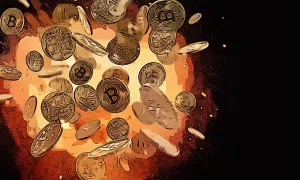Contents
Stablecoin USDC, which fell to a low of $0.8823 over the weekend due to the collapse of Silicon Valley Bank (SVB), has almost returned its peg to the dollar. The reason was the statement of the U.S. regulators and the coin’s operator, Circle.
In particular, the representative of the last mentioned claims that 100% of USDC reserves are safe because the government will support SVB. However, users’ fear of stablecoins, which sometimes turn out to be not so stable, can’t be stopped.
What happened?
In short, Circle’s USDC stablecoin lost its peg to the U.S. dollar after the collapse of Silicon Valley Bank, which specialized in lending money to technology companies.
It all started on March 10, when the California Department of Financial Protection and Innovation closed SVB due to fears about the bank’s financial condition. In particular, investors began withdrawing their funds massively. It became a negative signal for savers. The news of the bank’s $1.8B loss after selling $21B in bonds from its portfolio also made things worse.
The brand new newsletter with insights, market analysis and daily opportunities.
Let’s grow together!
Given that Silicon Valley Bank holds funds from a lot of crypto companies, the problems within the institution couldn’t help but affect the market. As it happens, the USDC stablecoin suffered the most from the SVB crash because Circle, the company that issues the coin, held $3.3B in reserves at Silicon Valley Bank. This money supported the price of the stablecoin, and its loss would have caused a financial blow to Circle.
1/ Following the confirmation at the end of today that the wires initiated on Thursday to remove balances were not yet processed, $3.3 billion of the ~$40 billion of USDC reserves remain at SVB.
— Circle (@circle) March 11, 2023
How badly has the USDC been hurt?
Speaking about stablecoins and their condition, one always recalls the infamous UST, which was pegged to USD and LUNA. Let’s remember that this asset also lost its peg to the U.S. dollar, so it fell from ~$0.9 to $0.002. And at the end of July 2022, another stablecoin called Nirvana (NIRV) also lost its peg to the dollar after the hacker attack. As a result, the coin collapsed by 94%.
As for USDC, the asset did not suffer such significant losses. The price of the coin fell only to $0.8823. Moreover, at the time of writing, the value of USDC has risen to $0.9901. In this regard, it can be assumed that the asset is not as weak as UST and NIRV and does not plan, at least for now, to fall to zero.
You have not selected any currency to displayCircle’s announcement of the USDC untie caused panic in the market; however, according to crypto expert Rudy | Nested, the company had no choice but to sell USDC on centralized and decentralized exchanges, which affected the tie-up.
DeFi-researcher Ignas believes that even though investors’ money is stuck at Silicon Valley Bank, it doesn’t mean it’s lost forever. Circle’s loss in this is $198M at $3.3B.
3/ More than 75% of the assets are sitting in Short-Dated US Treasury Portfolio with maturity date of 3 years or less.
It means that the missing hole will be filled from the interest payments in a few months. pic.twitter.com/nQ50TcEx1V
— Ignas | DeFi Research (@DefiIgnas) March 11, 2023
Binance CEO’s comment
Binance CEO Changpeng Zhao commented on the Silicon Valley Bank collapse, referring to Terra creator Do Kwon’s assertion that traditional banks pose risks to stablecoins.
“Banks have become risks for stablecoins backed by fiat currencies. In fact, Do Kwon was right, just wrong about the specific implementation of his ecosystem,” the Binance CEO said.
At the same time, the exchange also decided to play it safe, so it transferred funds from the $1B Industry Recovery Fund from BUSD stablecoin to BTC, BNB, and ETH. Some users saw this gesture as a collapse of the Binance stable coin. However, how things will actually turn out is still unclear.
This is surprising, moving from a “stable coin” into a volatile crypto as a recovery fund. Is this the end of $BUSD? Seems likely. On the positive side it should increase the price of $BTC and $ETH which will also lead to a price increase of #Radix $XRD.
In case somebody in the… https://t.co/PR8quSjquh
— TheTurbo (@TheTurbo2k19) March 13, 2023
What is the best way to hold crypto over the long term?
Given that a stablecoin does not always turn out to be stable, the question arises as to where and how best to keep one’s funds. However, there is probably no answer, because common cryptocurrencies, due to their excessive volatility, can also be dangerous. That’s why everything is extremely individual.
For now, as far as stablecoins are concerned, according to a recent CoinGecko analysis, users hold their savings in USDT the most. 80,3% of respondents hold this coin.
1/ What are the most commonly held #stablecoins among stablecoin owners?
Our recent survey with @lab_blockchain revealed that the most commonly owned stablecoins are: $USDT (80.3%), $USDC (50%) and $BUSD (50%).
Read the full report: https://t.co/nBN8ufuKtQ pic.twitter.com/bMCTQLVzJ2
— CoinGecko (@coingecko) March 13, 2023
As can be seen from the survey, investors often keep their money in more than one coin. The USDC, despite the recent de-peg, accounts for 50% of respondents.
However, there is reason to believe that the USDC situation will finally normalize. The head of Circle wrote that 100% of deposits from the bank are safe and will be available when the institution opens on March 14. The support of the U.S. government and financial regulators to mitigate risks also played a role. But, as always, we will continue to develop the situation.
Update thread on USDC
We were heartened to see the US government and financial regulators take crucial steps to mitigate risks extending from the fractional banking system.
100% of deposits from SVB are secure and will be available at banking open tomorrow.
— Jeremy Allaire (@jerallaire) March 12, 2023
What do you think will happen to stablecoins next, and are they that insecure? Share with us in the comments.






